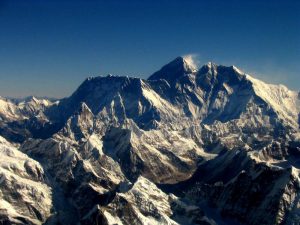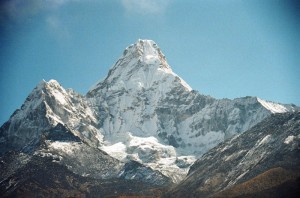Tagged as the most dangerous airport in the world, we found ourselves stranded for six days, 2840 metres high or 9318 ft in Lukla in the Solo Kumbu area of Nepal having just completed a ten day trek to view Mt Everest and the Tengboche Monastery.
Lukla is the gateway to the Everest region, a small town/village serviced by an air strip high in the Solo Kumbu. Each year thousands of tourist pass through here on their way to trek to Everest Base Camp for charity or for personal goals, trek to the start of a climb as this area is home to some of the most targeted mountains in the world or for those just wishing for a few days trekking in this high mountainous environment away from any vehicles and the noisy hustle and bustle of Kathmandu.
The only transport here are human porters, carrying loads sometimes heavier then their body weight, Yaks and Jubke, a cross between a cow and a yak. The porters and heavily laden animals slowly climb the rocky undulating paths to service the shops and local markets for the villagers who live high above Lukla in the Kumbu area and service the tea houses who cater for the tourist as they overnight on route.
Our trek had started well in brilliant sunshine with a perfect landing at Lukla airport and great views of Kongde Peak 6187m high). Kusum Kangguru (6367m) soon came into sight and the mighty Thamserku (6632m) filled the sky to our right. We had a glimpse of Mt Everest on route just before Namche Bazaar and good weather at Namche the next morning gave us the photo opportunity the clients had come for, the triangle of Mt Everest, showing above the Nuptse Lhotse face with Amabablam (6848m) standing magnificently on our right. We trekked further into the Kumbu area over nighting at Thame where we were invited into a Sherpa family house and then on to Kumjung the home of the Sir Edmund Hillary School, with Ama Dablam and Thamserku forever watching over us. At Phortse the weather changed and by the time we reached Tengboche passing our trekking highpoint of 4150m, we were in the clouds with visibility down to as little as fifty metres offering no view of nearby Everest and Ama Dablam.
We rose at 6.30am to an early morning of very low cloud and during breakfast and as if on cue, the clouds cleared affording us the view we had trekked for, Mt Everest big and bold and close, right there in front of us. Porridge getting cold and eggs abandoned, people rushed outside to capture this moment, glad that they had as it disappeared as fast as it had come, the last we were to see of blue sky and the sun.
We returned to Namche Bazaar and moved down towards Lukla knowing that the airport had been closed for two days due to the bad weather. With no one leaving Lukla due to the airport closure, Tea houses were full, and would be departees backed up as far as Phakding. A telephone call assured us our rooms at Lukla were clear as reserved so we continued down to claim them, not knowing we were to spend the next six nights there.There were thousands of disappointed people waiting in Kathmandu for flights to Lukla to start their treks with thousands more trying to return to Kathmandu to catch international flights back home to the numerous countries represented in the thousands stranded.
A four day walk to the nearest road followed by a twelve hour bus ride was one option, or the hiring of a helicopter was the other. The helicopter was able to land below the clouds at Surkhe a village 600 metres and two hours walk below Lukla.
Many chose this second option and descended to Surta hopeful of a helicopter ride, only to find hundreds waiting in appalling conditions, wet and cold with no place to stay as the only tea house was full. Local people opened there houses as they saw this as a way to make money, charging for a space on the mud floor of their one roomed houses. The few helicopters that made it here were forced to retreat, as scuffles broke out, as the hirer was gazumped as the demand for places was now in the hands of the highest bidder. The scene became very ugly and fighting broke out and even with the support of stick wielding police only about twenty people were successfully evacuated.
I decided we should stay put in our tea house, Namaste Lodge, and wait for a break in the weather as we were warm, dry, well fed with a half decent bed each. After six days the weather broke and we awoke to the sound of a siren and bright sunshine and the first plane arrived at 7.05 am to loud cheers. They continued buzzing in and out all day each taking the maximum of twenty passengers and their luggage. With our international flights deadline now passed, and the back log of flights immense , a group as large as ours(18) trying to fly out together and wait for a free plane forced us continually backwards in the queue, the only option was to split the group.
The next morning we rose again to blue skies and sunshine, but no planes, why? Fog at Kathmandu airport.
At 9.30am the siren sounded signalling planes had departed from Kathmandu and the planes buzzed in around 10 .15am. We managed to get four of our group a flight around mid day, followed by another four then six during the course of the day leaving one lady client, Marian, our two Nepalese trek leaders and me. The next morning we made our way to the airport for 8am and within an hour Marian had boarded and I followed on shortly afterwards arriving in Kathmandu at mid day to say farewell to my group who had been re scheduled with international flights . Both our Trek guides Ajay and Dipesh finally caught the last flight of the day and we were able to meet up later that evening in Kilroy’s restaurant in Kathmandu. At 10 am the next day Marian and I transferred to Kathmandu airport for our 12.55 flight home.




